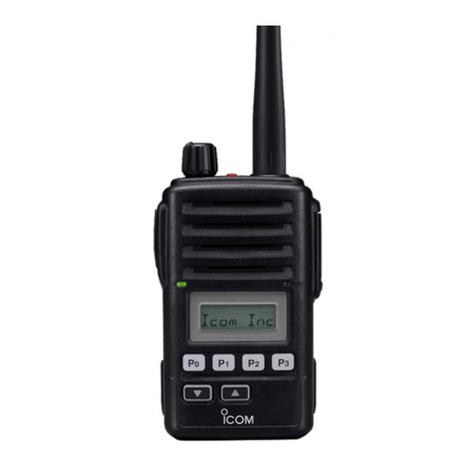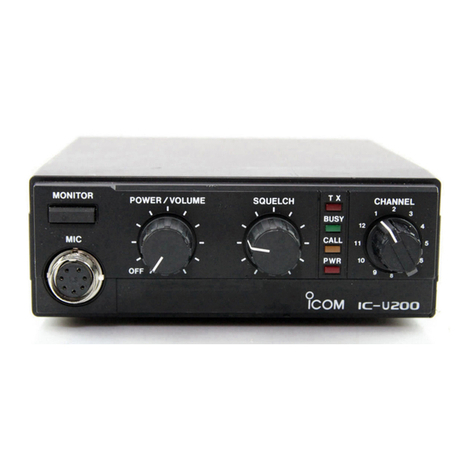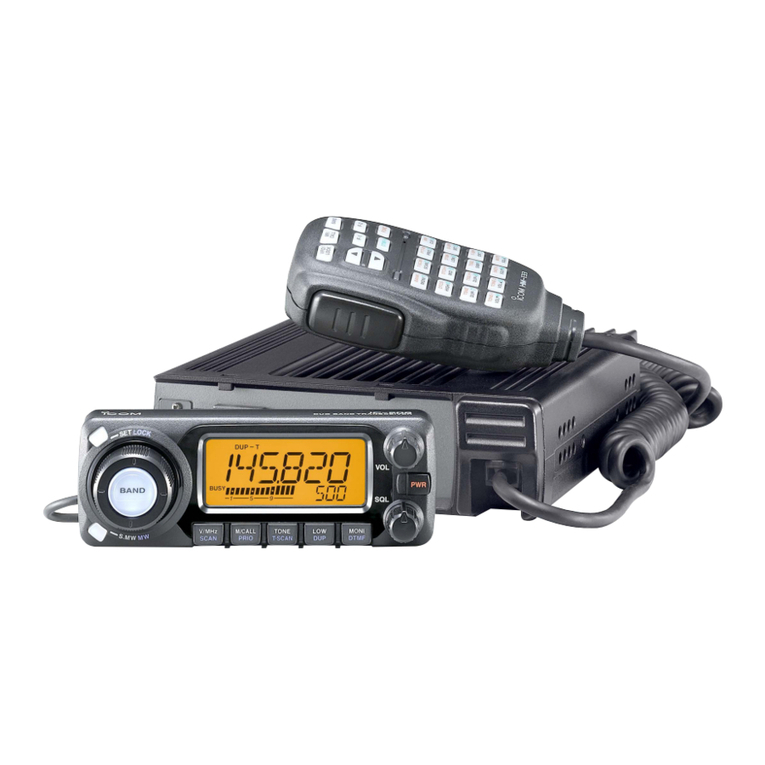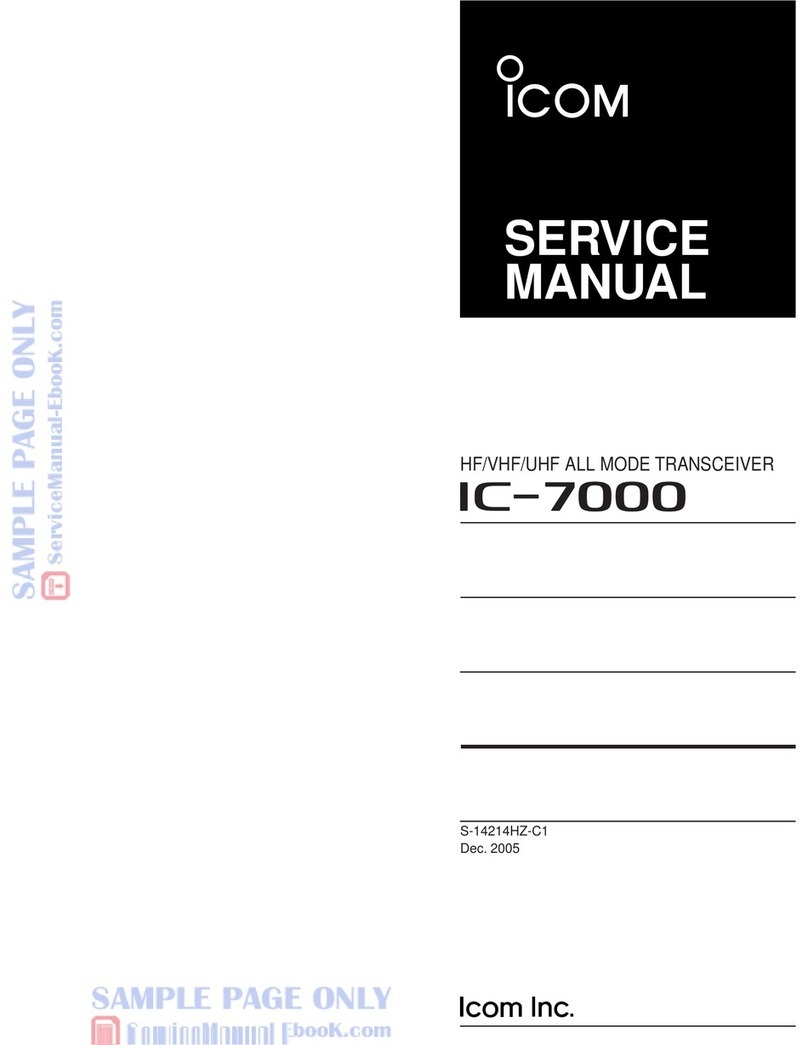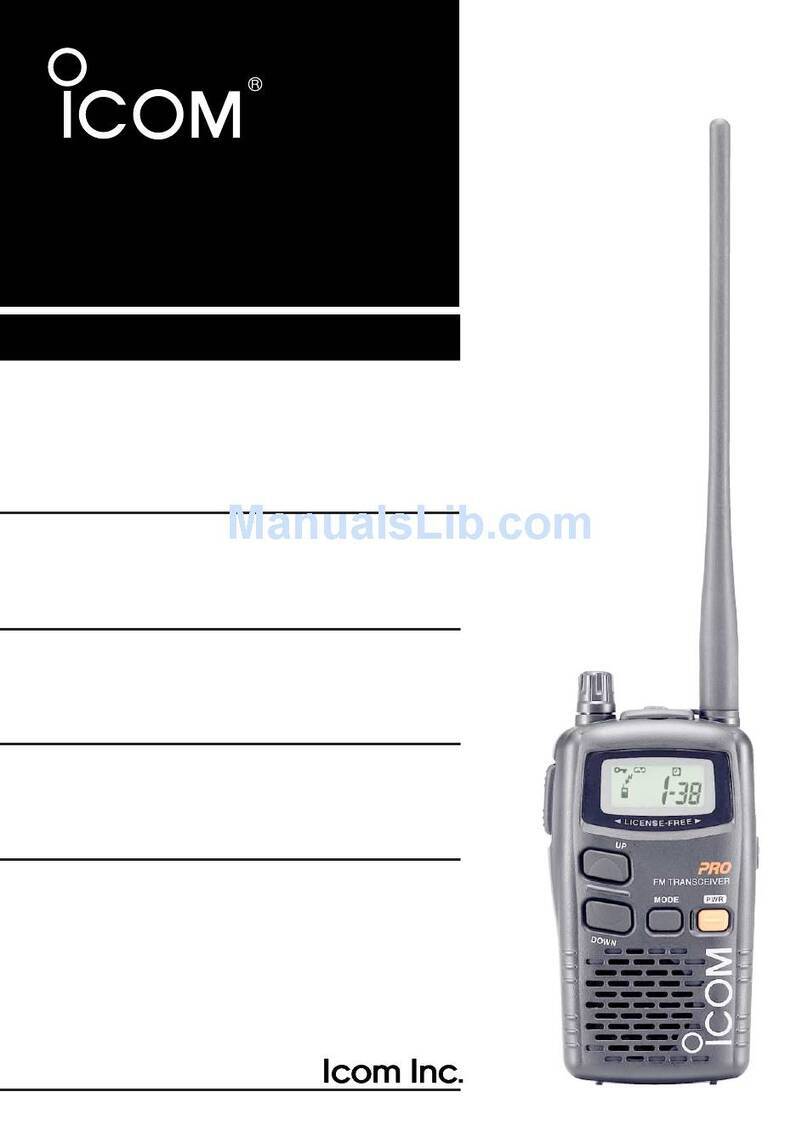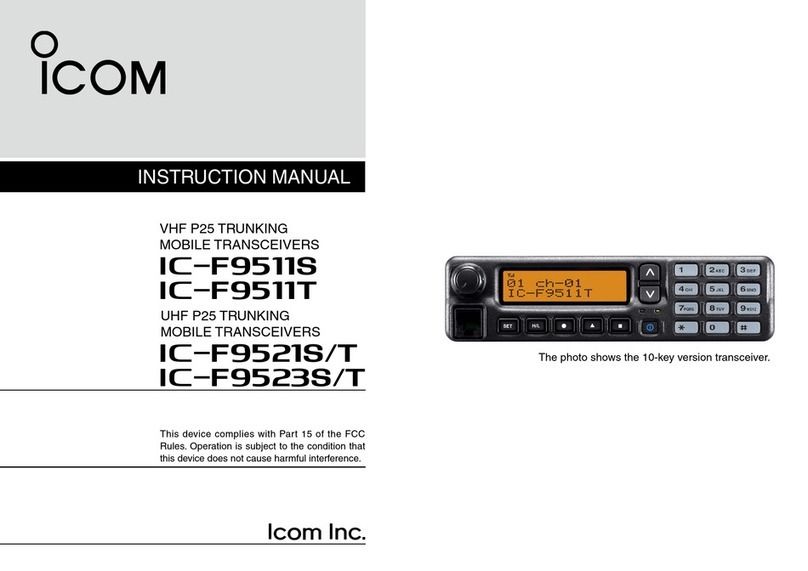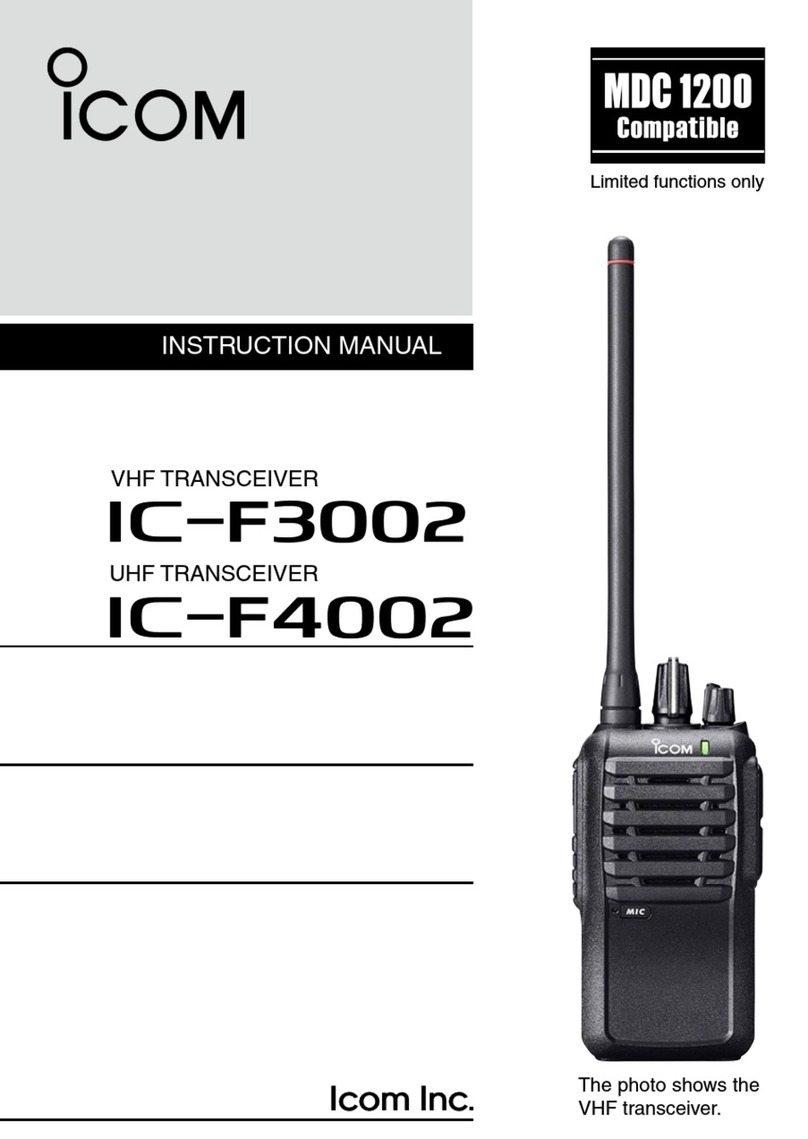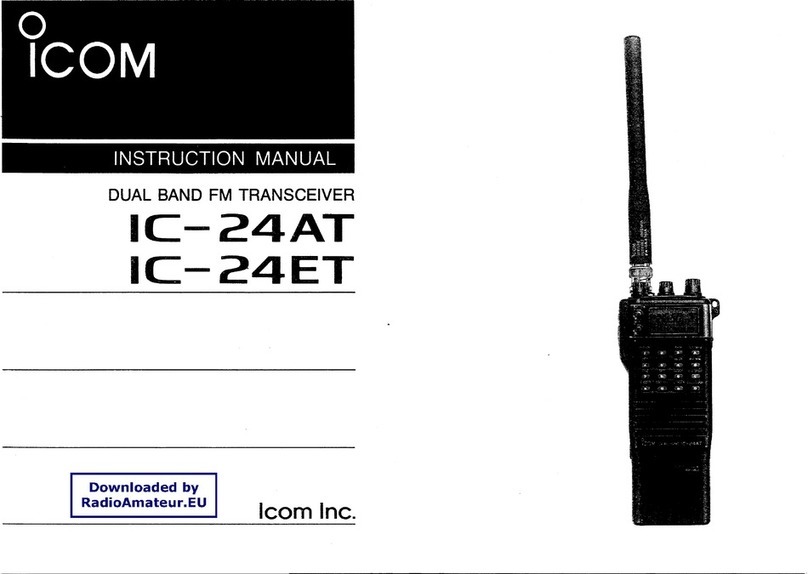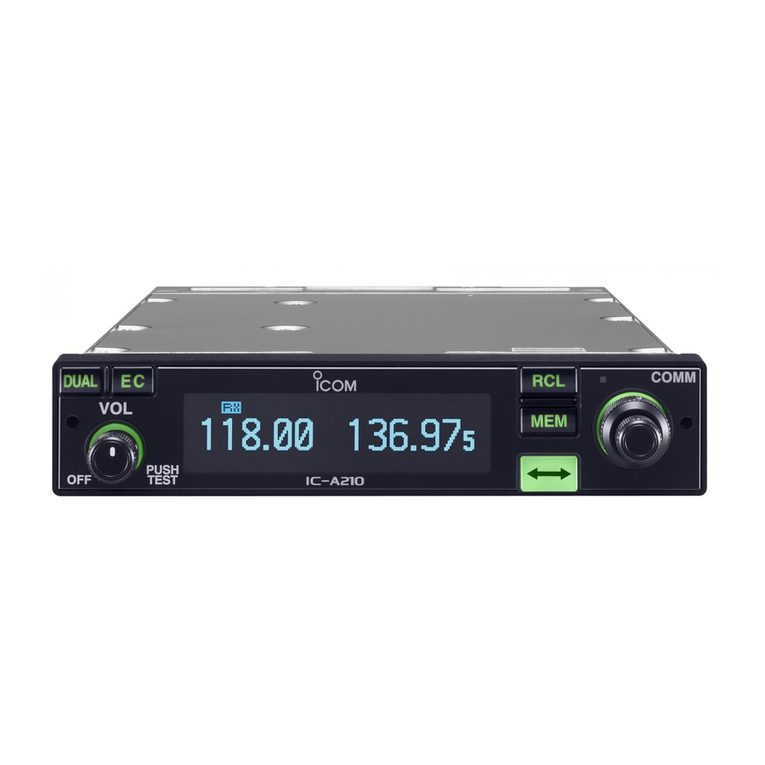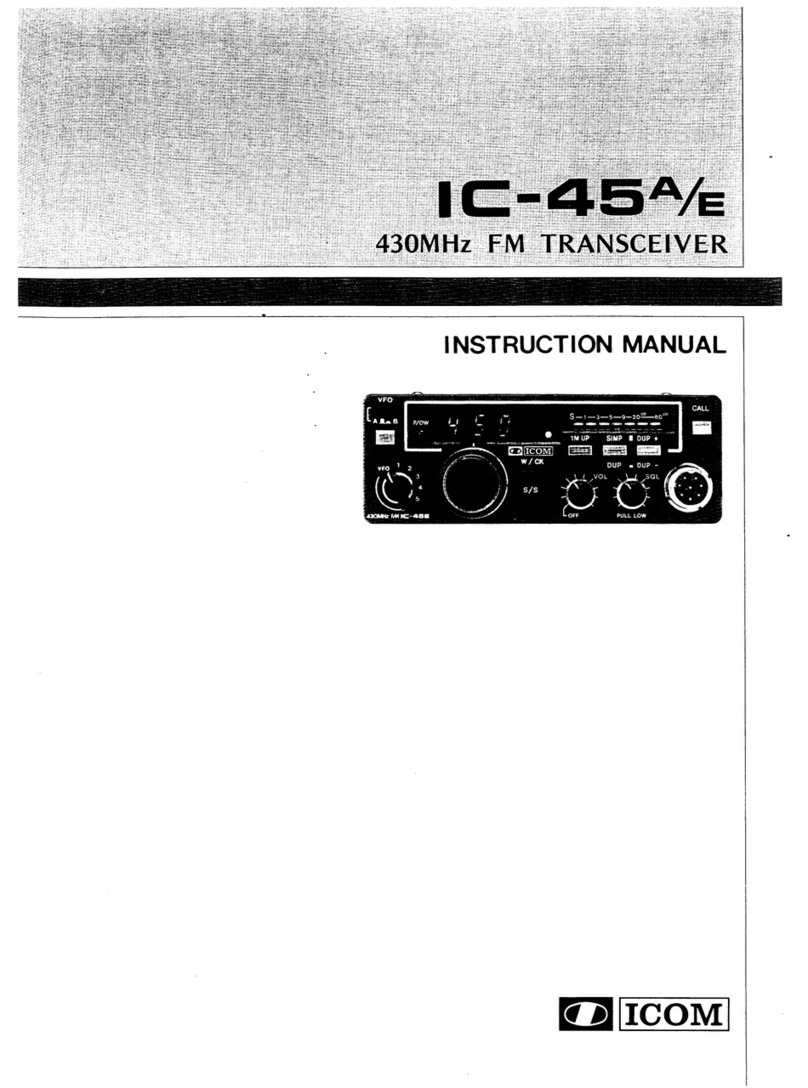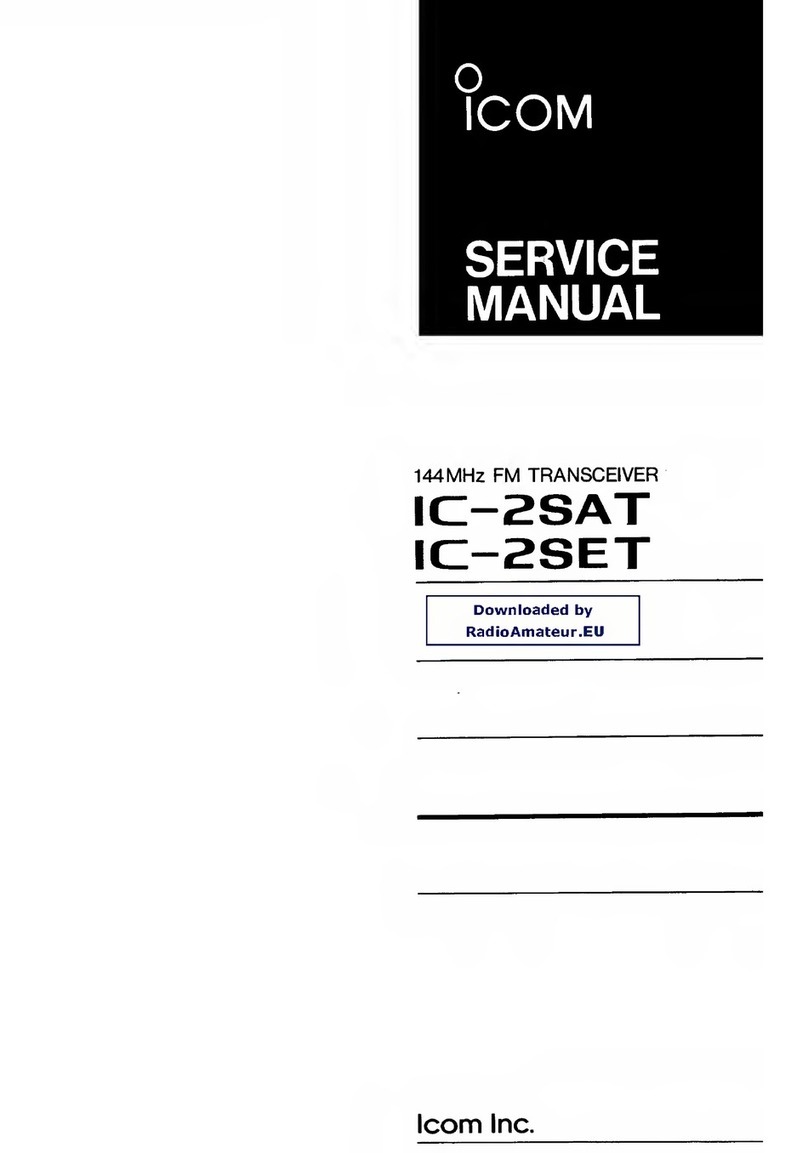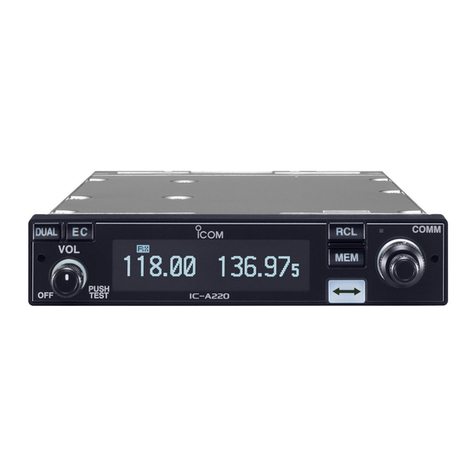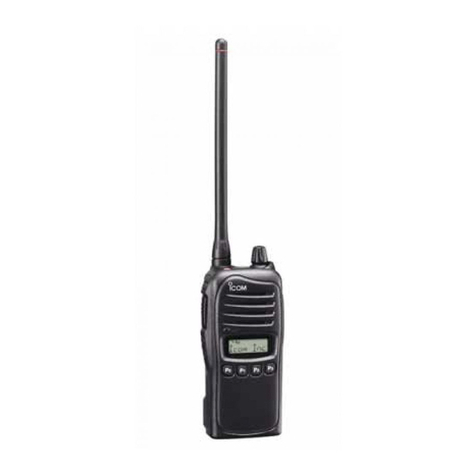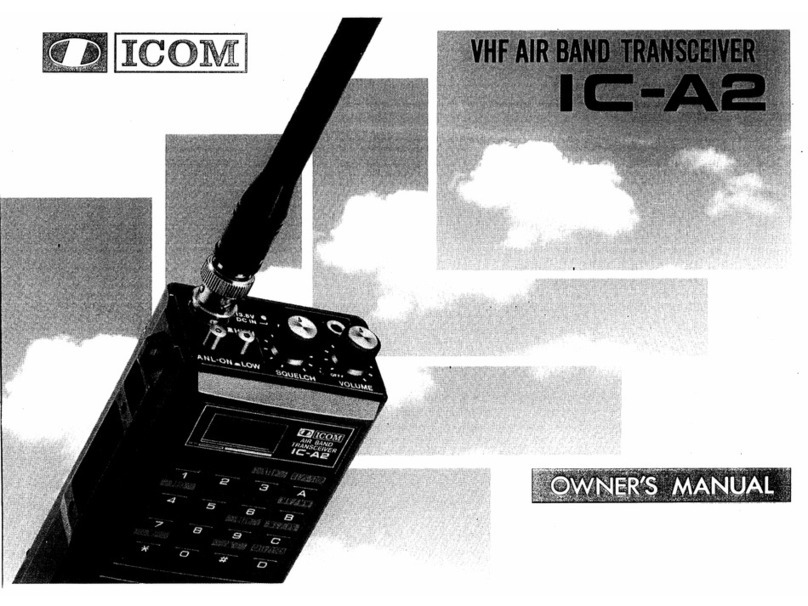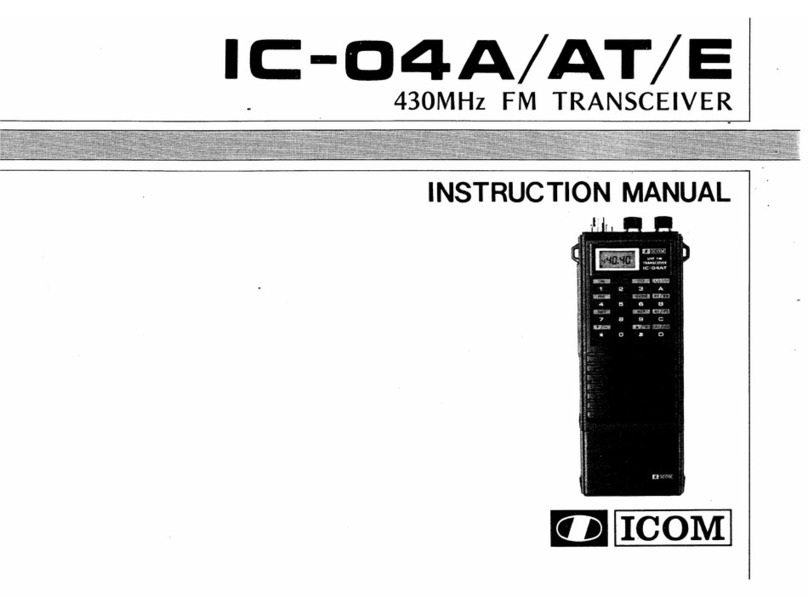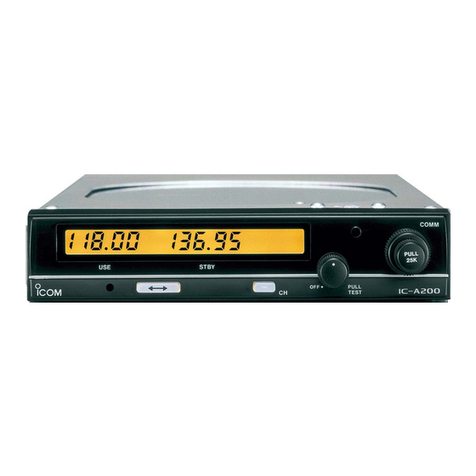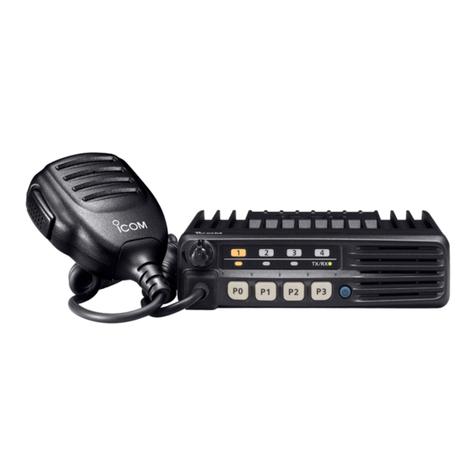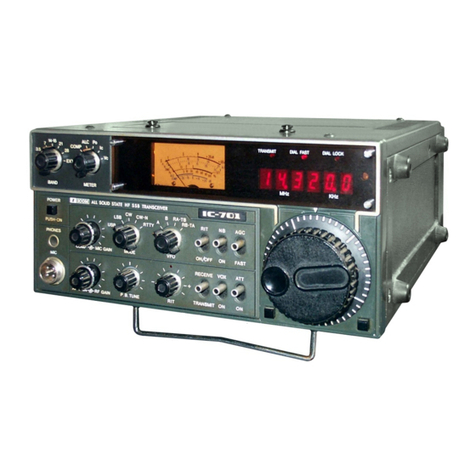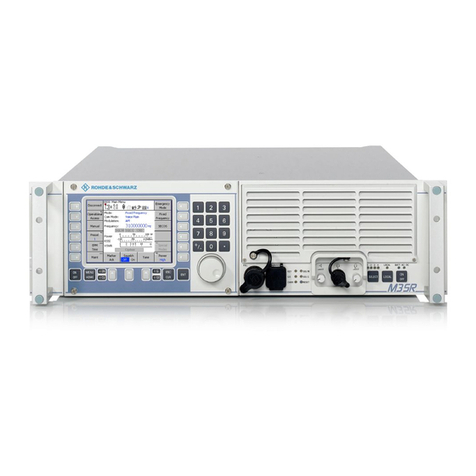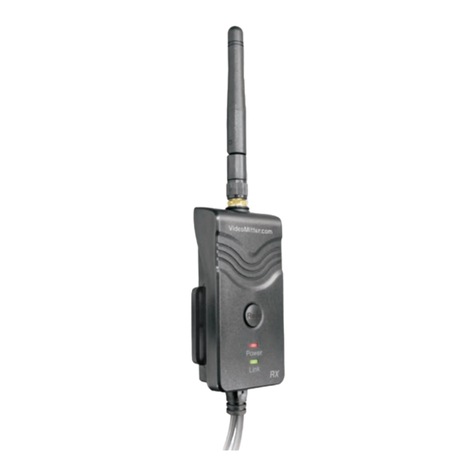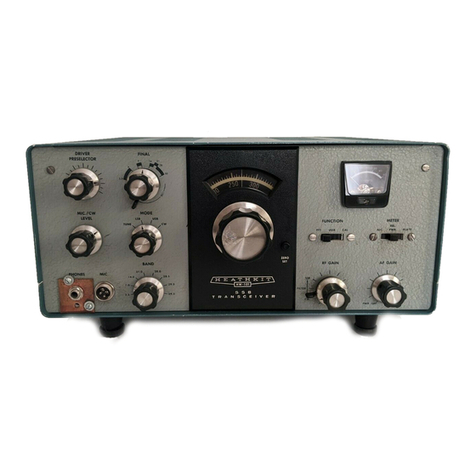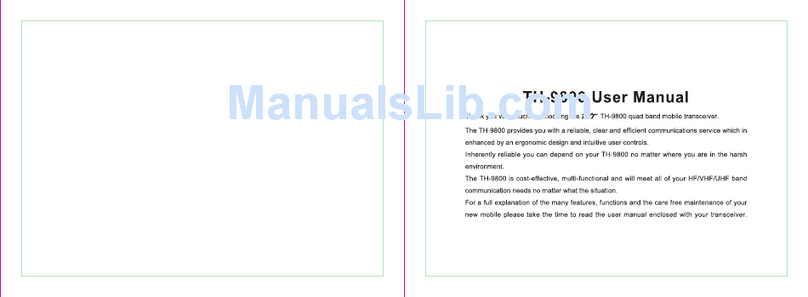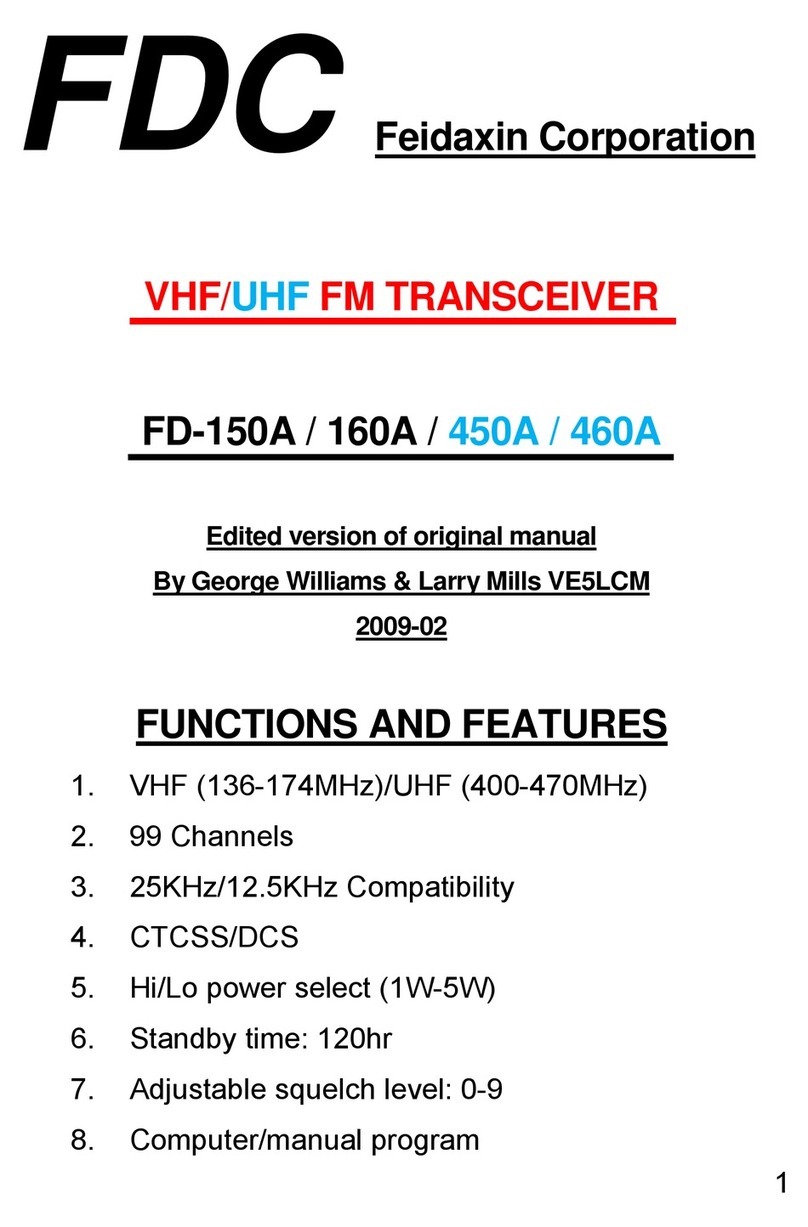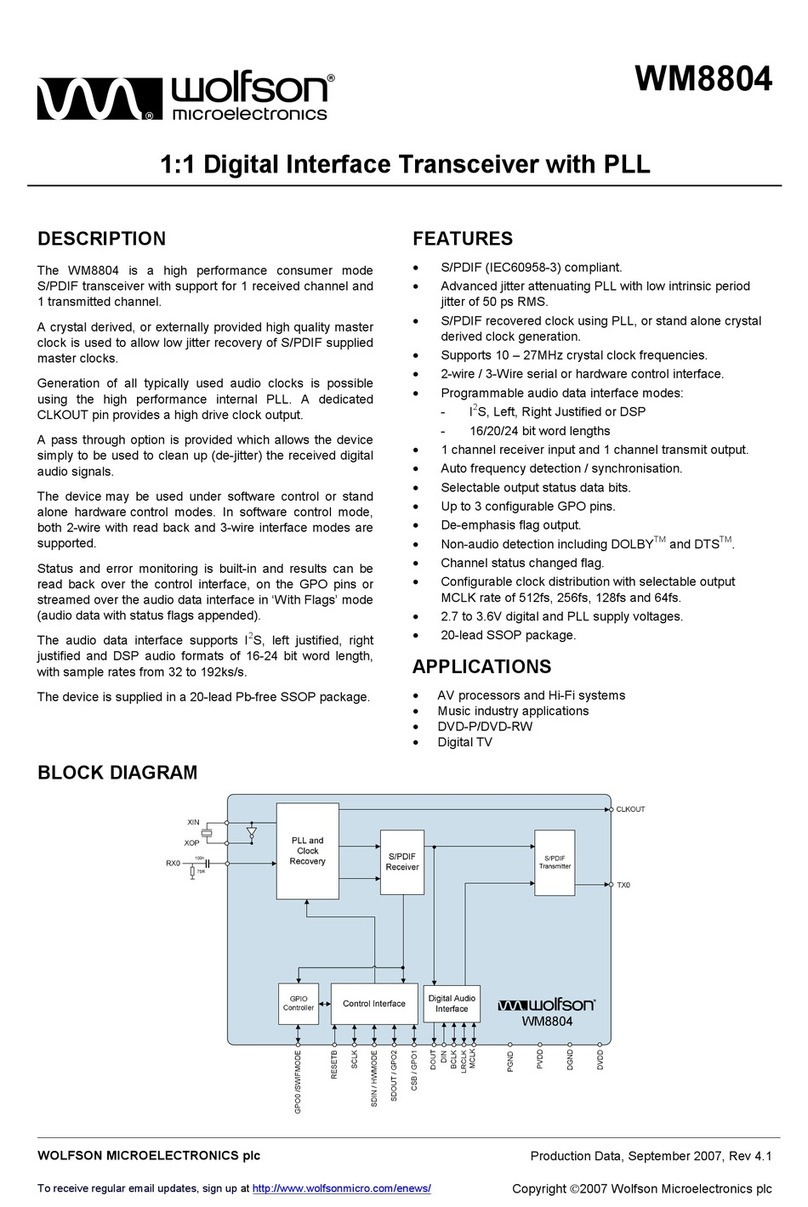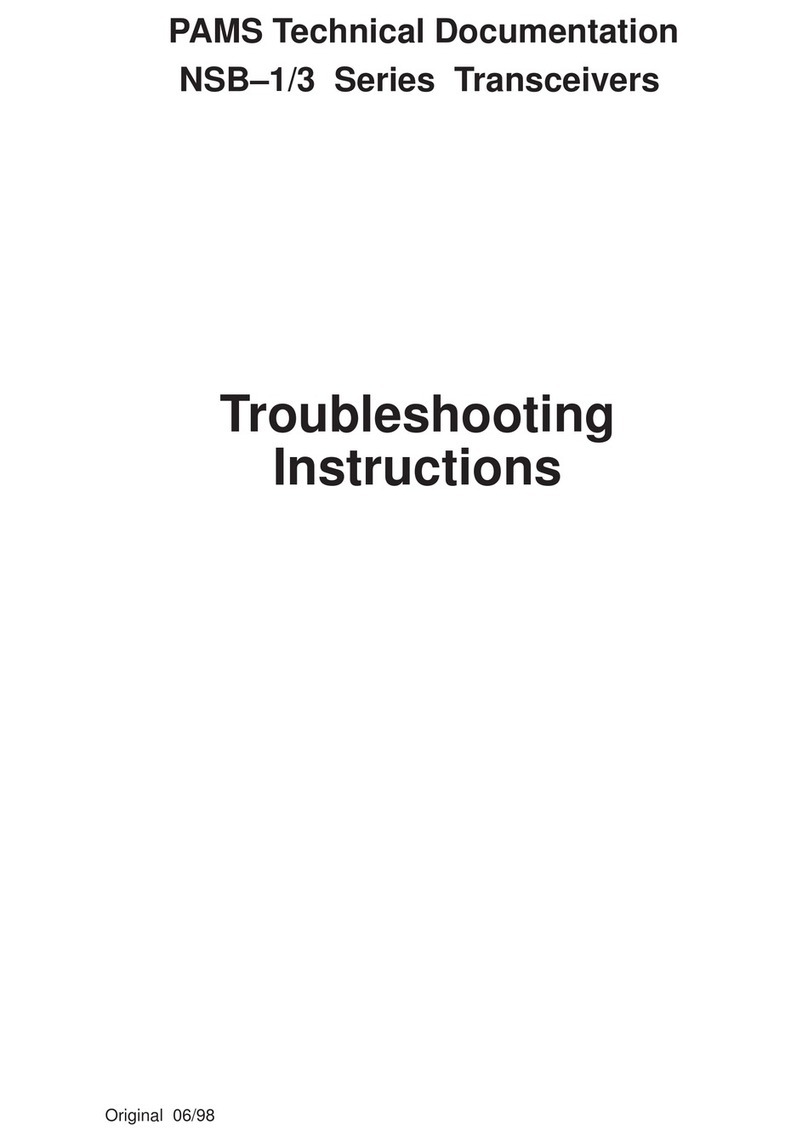Icom IC-M603 User manual

INSTRUCTION MANUAL
iM603
VHF MARINE TRANSCEIVER

i
FOREWORD
Thank you for purchasing this Icom transceiver. The IC-
M603 vhf marine transceiver is designed and built with
Icom’s state of the art technology and craftsmanship. With
proper care, this transceiver should provide you with years
of trouble-free operation.
We want to take a couple of moments of your time to thank
you for making the IC-M603 your radio of choice, and hope
you agree with Icom’s philosophy of “technology first.” Many
hours of research and development went into the design of
your IC-M603.
DFEATURES
❍Built-in DSC meets ITU Class D requirement
❍Rugged waterproof construction
❍Large LCD with dot matrix characters
❍Front and rear panel microphone connection
❍Optional COMMANDMICIII™ (HM-162E) are
available and up to two COMMANDMICIII™s
can be connected
❍Easy to make individual DSC calls using Icom's
MA-500TR Class B AIS Transponder
IMPORTANT
READ ALL INSTRUCTIONS carefully and completely
before using the transceiver.
SAVE THIS INSTRUCTION MANUAL — This in-
struction manual contains important operating instructions
for the IC-M603.
EXPLICIT DEFINITIONS
CLEAN THE TRANSCEIVER AND MICROPHONE
THOROUGHLY WITH FRESH WATER after exposure to
water including salt, otherwise, the keys and switch may
become inoperable due to salt crystallization.
WORD DEFINITION
RWARNING! Personal injury, fire hazard or electric
shock may occur.
CAUTION Equipment damage may occur.
NOTE Recommended for optimum use. No risk
of personal injury, fire or electric shock.

ii
IN CASE OF EMERGENCY
If your vessel requires assistance, contact other vessels and
the Coast Guard by sending a Distress call on Channel 16.
USING CHANNEL 16
DISTRESS CALL PROCEDURE
1. “MAYDAY MAYDAY MAYDAY.”
2. “THIS IS ...............” (name of vessel).
3. Say your call sign or other indication of the vessel (AND
9-digit DSC ID if you have one).
4. “LOCATED AT ...............” (your position).
5. State the nature of the distress and assistance required.
6. Give any other information which might facilitate the
rescue.
Or, transmit your Distress call using digital selective calling
on Channel 70.
USING DIGITAL SELECTIVE CALLING (Ch 70)
DISTRESS CALL PROCEDURE
1.
While lifting up the key cover, push and hold [DISTRESS]
for 5 sec.
until you hear 5 short beeps change to one
long beep.
2. Wait for an acknowledgment on Channel 70 from a
coast station.
•Aftertheacknowledgementisreceived,Channel16isauto-
matically selected.
3. Push and hold [PTT], then transmit the appropriate
information as listed above.
INSTALLATION NOTE
The installation of this equipment should be made in such a
manner as to respect the EC recommended electromagnetic
field exposure limits (1999/519/EC).
The maximum RF power available from this device is 25
watts. The antenna should be installed as high as possi-
ble for maximum efficiency and that this installation height
should be at least 5 meters above ground (or accessible)
level. In the case where an antenna cannot be installed at
a reasonable height, then the transmitter should neither be
continuously operated for long periods if any person is within
5 meters of the antenna, nor operated at all if any person is
touching the antenna.
In all cases any possible risk depends on the transmitter
being activated for long periods. (actual recommendation
limits are specified as an average of 6 minutes) Normally the
transmitter is not active for long periods of time. Some radio
licenses will require that a timer circuit automatically cuts the
transmitter after 1–2 minutes etc.
Similarly some types of transmitter, SSB, CW, AM, etc. have
a lower ‘average’ output power and the perceived risk is even
lower.

iii
DOC
CE versions of the IC-M603 which display the
“CE” symbol on the serial number label, com-
ply with the essential requirements of the Eu-
ropean Radio and Telecommunication Terminal
Directive 1999/5/EC.
This warning symbol indicates that this equip-
ment operates in non-harmonised frequency
bands and/or may be subject to licensing condi-
tions in the country of use. Be sure to check that
you have the correct version of this radio or the
correct programming of this radio, to comply with
national licensing requirement.
DECLARATION
OF CONFORMITY
We Icom Inc. Japan
1-1-32, Kamiminami, Hirano-ku
Osaka 547-0003, Japan
Kind of equipment:
VHF MARINE TRANSCEIVER
This compliances is based on conformity with the following harmonised
standards, specifications or documents:
i)
EN 301 025-2 V1.2.1 (2004-09)
ii)
EN 301 025-3 V1.2.1 (2004-09)
iii) EN 60945 2002
iv) EN 60950-1 2001
v) EN 300 698-2 V1.1.1 ( 2000-08)
vi) EN 300 698-3 V1.1.1 ( 2001-05)
Type-designation: iM603
Signature
Declare on our sole responsibility that this equipment complies with the
essential requirements of the Radio and Telecommunications Terminal
Equipment Directive, 1999/5/EC, and that any applicable Essential Test
Suite measurements have been performed.
Version (where applicable):
0560
Authorized representative name
Place and date of issue
1st Jul. 2006

iv
1
2
3
4
5
6
7
8
9
10
11
12
FOREWORD .................................................................................. i
IMPORTANT ................................................................................... i
EXPLICIT DEFINITIONS ................................................................ i
IN CASE OF EMERGENCY ........................................................... ii
INSTALLATION NOTE .................................................................... ii
DOC ............................................................................................... iii
TABLE OF CONTENTS ................................................................. iv
PRECAUTIONS ............................................................................. v
1 OPERATING RULES ............................................................... 1
2 PANEL DESCRIPTION ........................................................ 2–6
■Panel description .................................................................. 2
■Function display .................................................................... 4
■Microphone ........................................................................... 6
3 BASIC OPERATION .......................................................... 7–12
■Channel selection ................................................................. 7
■Receiving and transmitting ................................................... 9
■Call channel programming .................................................. 10
■Microphone lock function .................................................... 10
■Display backlight ................................................................. 10
■Channel comments ............................................................. 11
■AquaQuake water draining function .................................... 11
■Optional Voice scrambler operation .................................... 12
4 DUALWATCH/TRI-WATCH .................................................... 13
■Description .......................................................................... 13
■Operation ............................................................................ 13
5 SCAN OPERATION ......................................................... 14–15
■Scan types .......................................................................... 14
■Setting TAG channels ......................................................... 15
■Starting a scan .................................................................... 15
6 DSC OPERATION ............................................................ 16–38
■MMSI code programming ................................................... 16
■DSC address ID .................................................................. 16
■Position and Time programming ......................................... 18
■Position and Time indication ............................................... 19
■GPS information indication ................................................. 19
■Distress call ........................................................................ 20
■Transmitting DSC calls ........................................................ 23
■Receiving DSC calls ........................................................... 32
■Received messages ........................................................... 36
■DSC Set mode .................................................................... 37
7 OTHER FUNCTIONS ....................................................... 39–42
■Intercom operation .............................................................. 39
■Hailer operation .................................................................. 40
■Automatic foghorn ............................................................... 41
■RX speaker function ........................................................... 42
8 SET MODE ....................................................................... 43–45
■Set mode programming ...................................................... 43
■Set mode items ................................................................... 43
9 CONNECTIONS AND MAINTENANCE ........................... 46–53
■Connections ........................................................................ 46
■Antenna .............................................................................. 47
■Fuse replacement ............................................................... 47
■Supplied accessories .......................................................... 47
■Microphone hanger ............................................................. 47
■Mounting the transceiver .................................................... 48
■MB-75 installation ............................................................... 49
■UT-112/UT-98 installation .................................................... 50
■HM-162E installation ........................................................... 51
10 TROUBLESHOOTING ............................................................ 53
11 SPECIFICATIONS AND OPTIONS .................................. 54–55
■Specifications....................................................................... 54
■Options ................................................................................ 55
12 CHANNEL LIST ............................................................... 56–57
TABLE OF CONTENTS

v
RWARNING! NEVER connect the transceiver to an
AC outlet. This may pose a fire hazard or result in an electric
shock.
RWARNING! NEVER connect the transceiver to a
power source of more than 16 V DC or use reverse polarity.
This will ruin the transceiver.
RWARNING! NEVER cut the DC power cable between
the DC plug and fuse holder. If an incorrect connection is
made after cutting, the transceiver may be damaged.
CAUTION: NEVER place the transceiver where normal
operation of the vessel may be hindered or where it could
cause bodily injury.
KEEP the transceiver and microphone at least 1 m away
from the vessel’s magnetic navigation compass.
DO NOT use or place the transceiver in areas with tem-
peratures below –20°C or above +60°C or, in areas subject
to direct sunlight, such as the dashboard.
DO NOT use chemical agents such as benzine or alcohol
when cleaning, as they may damage the transceiver sur-
faces. If the transceiver becomes dusty or dirty, wipe it clean
with a soft, dry cloth.
BE CAREFUL! The transceiver rear panel will become
hot when operating continuously for long periods.
Place the transceiver in a secure place to avoid inadvertent
use by children.
BE CAREFUL! The transceiver and the optional HM-
162E* commandmiciii™employ waterproof construction,
which corresponds to IPX7. However, once the transceiver
or microphone has been dropped, waterproof protection
cannot be guaranteed because of possible damage to the
transceiver’s or microphone’s case, or the waterproof seal.
* Equivalent to IPX8
Approved Icom optional equipment is designed for optimal
performance when used with an Icom transceiver.
Icom is not responsible for the destruction or damage to an
Icom transceiver in the event the Icom transceiver is used
with equipment that is not manufactured or approved by Icom.
PRECAUTIONS

1
1
OPERATING RULES
1
DPRIORITIES
•Readallrulesandregulationspertainingtoprioritiesand
keep an up-to-date copy handy. Safety and Distress calls
take priority over all others.
•YoumustmonitorChannel16whenyouarenotoperating
on another channel.
•Falseorfraudulentdistresssignalsareprohibitedand
punishable by law.
DPRIVACY
•Informationoverheardbutnotintendedforyoucannotlaw-
fully be used in any way.
•Indecentorprofanelanguageisprohibited.
DRADIO LICENSES
(1) SHIP STATION LICENSE
You must have a current radio station license before using
the transceiver. It is unlawful to operate a ship station which
is not licensed.
Inquire through your dealer or the appropriate government
agency for a Ship-Radiotelephone license application. This
government-issued license states the call sign which is your
craft’s identification for radio purposes.
(2) OPERATOR’S LICENSE
A Restricted Radiotelephone Operator Permit is the license
most often held by small vessel radio operators when a radio
is not required for safety purposes.
The Restricted Radiotelephone Operator Permit must be
posted or kept with the operator. Only a licensed radio op-
erator may operate a transceiver.
However, non-licensed individuals may talk over a trans-
ceiver if a licensed operator starts, supervises, ends the call
and makes the necessary log entries.
Keep a copy of the current government rules and regulations
handy.
Icom, Icom Inc. and the Icom logo are registered trademarks of Icom Incor-
porated (Japan) in Japan, the United States, the United Kingdom, Germany,
France, Spain, Russia and/or other countries.
COMMANDMIC is a registered trademark of Icom Incorporated (Japan) in the
United States.

2
PANEL DESCRIPTION
2
■Panel description
POWER
VOL
iM603
VHF MARINE
MIC
C
H/L
DIAL
16
SQL
DISTRESS
H/L
DIAL
C
16
Speaker Function display (p. 4) !3
q!2 tyui!1 !0 orew
qCLEAR KEY [CLR]
Push to cancel the entered function, exit Set mode. (p. 43)
wFUNCTION KEY [F]
After pushing this key, some keys perform secondary
functions.
•“F” appears when a secondary function can be accessed.
eDISTRESS KEY [DISTRESS] (pp. 20, 22)
Push and hold for 5 sec. to transmit a Distress call.
rDSC MENU KEY [MENU] (p. 16)
Push to toggle the DSC menu ON or OFF.
tPOWER KEY [POWER] (p. 9)
➥Push to turn power ON.
➥Push and hold for 1 sec. to turn power OFF.
yCHANNEL16/CALLCHANNELKEY[16•C]
➥Push to select Channel 16. (p. 7)
➥Push and hold for 1 sec. to select call channel. (p. 7)
•“CALL” appears when call channel is selected.
➥Push and hold for 3 sec. to enter call channel program-
ming condition when call channel is selected. (p. 10)
➥While pushing and holding [H/L], push to enter channel
comments programming condition. (p. 11)
➥
While turning power ON, push to enter Set mode. (p. 43)
uSELECTOR DIAL [SELECTOR] (pp. 7–9)
Rotate to select the operating channels, set mode con-
tents, etc.
iDIAL KEY [DIAL]
➥Selects to the regular channel. (p. 8)
➥While pushing and holding [H/L], push to select one of
three channel groups in sequence. (p. 8)
•EURversionhasInternationalchannelsonlyandthisfunc-
tion is not available.
oSQUELCH CONTROL [SQL] (p. 9)
Rotate to set the squelch threshold level.

3
2
PANEL DESCRIPTION
2
!0 TRANSMIT POWER KEY [H/L]
➥Push to toggle the output power high or low. (p. 9)
•Somechannelsaresettolowpoweronly.
➥While pushing and holding this key, some keys perform
secondary functions.
!1 VOLUME CONTROL [VOL] (p. 9)
Rotate to adjust the audio level.
!2 MIC CONNECTOR
Connect the supplied microphone only.
CAUTION: NEVER connect another microphone here,
such as the optional COMMANDMICIII™. It may cause
damage to the transceiver.
!3 KEYPAD
➥Inputs numerals for channel number input, etc.
•Afterinputtingthedesiredchannelnumber,push[ENT].
•Pushandhold[0•A]to input ‘A’ for simplex channels.
➥Inputs numeral, alphabet and some symbols for chan-
nel comment input.
➥
After pushing [F], push to perform the secondary function.
•Mostofsecondaryfunctions(exceptTAGchannelsetting,
RX speaker and Auto foghorn functions) can be cleared or
cancelled when [CLR] is pushed.
➥Number input: ‘1’
➥Comment input: ‘1,’ ‘Q,’ ‘Z,’ ‘q,’ ‘z’ or space
➥After pushing [F], push to turn the Dualwatch
function ON or OFF. (p. 13)
➥Number input: ‘2’
➥Comment input: ‘2,’ ‘A,’ ‘B,’ ‘C’ ‘a,’ ‘b’ or ‘c’
➥After pushing [F], push to turn the Tri-watch
function ON or OFF. (p. 13)
➥Number input: ‘3’
➥Comment input: ‘3,’ ‘D,’ ‘E,’ ‘F,’ ‘d,’ ‘e’ or ‘f’
➥After pushing [F], push this key then rotate
[SELECTOR] to adjust the brightness of the
LCD and key backlight. (p. 10)
➥Number input: ‘4’
➥Comment input: ‘4,’ ‘G,’ ‘H,’ ‘I,’ ‘g,’ ‘h’ or ‘i’
➥After pushing [F], push to start or stop the scan
function. (p. 15)
➥Number input: ‘5’
➥Comment input: ‘5,’ ‘J,’ ‘K,’ ‘L,’ ‘j,’ ‘k’ or ‘l’
➥After pushing [F], push to set the displayed
channel as a TAG channel. (p. 15)
➥While pushing and holding [H/L], push for 3 sec.
to clear or set all TAG channels. (p. 15)
➥Number input: ‘6’
➥Comment input: ‘6,’ ‘M,’ ‘N,’ ‘O,’ ‘m,’ ‘n’ or ‘o’

When the lcom MA-500TR CLASS B AIS TRANSPONDER is con-
nected to your IC-M504/IC-M505/IC-M603/IC-M604 VHF MARINE
TRANSCEIVER, an individual DSC call can be transmitted to a
selected AIS target using the transponder, without needing to
enter the target’s MMSI code.
See the transponder’s manual for connecting instructions.
To ensure correct operation of the DSC function, make
sure you correctly set the transceiver’s squelch.
MAKING AN INDIVIDUAL DSC CALL USING AN AIS TRANSPONDER
Procedures Transponder’s display Transceiver’s display
Step q: Transponder’s operation
Select a desired AIS target on the plotter, target list or danger list
display.
• You can also go to the next step whenever the detail screen of the AIS
target is displayed.
• Make sure the transceiver is in the normal operating mode. Otherwise,
you cannot make an individual DSC call using the transponder.
Step w: Transponder’s operation
Push [DSC] to display the voice channel selection screen, and then
push [Y] or [Z]to select a desired voice channel*.
• Voice channels are already preset into the transponder in recommended
order.
*When a base station is selected in step q, a voice channel will be spec-
ified by the base station, therefore you cannot change the channel. The
transponder will display “Voice Channel is specified by the Base station,”
in this case.
Step e: Transponder’s operation
Push [DSC] to make the transceiver to transmit an individual DSC
call to the AIS target.
• If Channel 70 is busy, the transceiver stands by until the channel becomes
clear.
• If the transceiver cannot make the call, the transponder will display “DSC
Transmission FAILED.”
Individual Call
Step r: Transponder’s operation
After making the individual DSC call, the transponder will display
“DSC Transmission COMPLETED.”
• Push [CLEAR] to return to the previous screen before you entered the
voice channel selection screen in step w.
• The transceiver stands by on Channel 70 until an acknowledgement is
received.
Individual Call
TX Complete
Now Waiting for ACK
<CLR Exit>
Step t: Transceiver’s operation
When the acknowledgement ‘Able to comply’ is received, beeps
sound and the transceiver automatically selects the channel spec-
ified in step w.
If the acknowledgement ‘Unable to comply’ is received, beeps sound
and the transceiver’s display returns to the operating channel select-
ed before making the individual DSC call.
• Push [CLR] to stop the beeps.
• You can check the MMSI code or the name (if programmed) of the AIS
target on the display.
Step y: Transceiver’s operation
After receiving the acknowledgement ‘Able to comply’ in step t,
push and hold [PTT] to communicate with the AIS target.
[DSC]
[CLEAR]
[Z]
[Y]
TRANSPONDER
A-6527D-3EX
25W INT
DUP
Received
Unable ACK
<123456789
<CLR˘
Beep Off> INTL
‘Unable to comply’ is received.
16
TRANSCEIVER (IC-M603/M604)
[CLR]
[PTT]
(Example)
25W INT
DUP
34°34.506N
123°23.236W
UTC 12:00 INTL
‘Able to comply’ is received
‘Unable to comply’ is received
25W INT
Received
INDV ACK
<123456789
<CLR˘
Beep Off> COMMERCIAL
These instructions are based on using the IC-M604. The dis-
played screens, indications or operations may differ slightly
from the instructions, depending on the transceiver.
Other manuals for IC-M603
4
Other Icom Transceiver manuals
Popular Transceiver manuals by other brands

Alan
Alan HP450 2A Rugged user manual
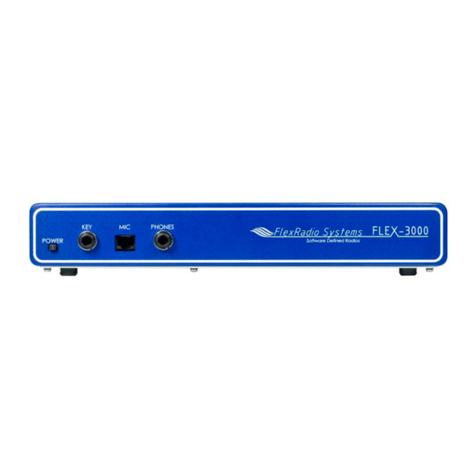
FlexRadio Systems
FlexRadio Systems Flex-3000 owner's manual
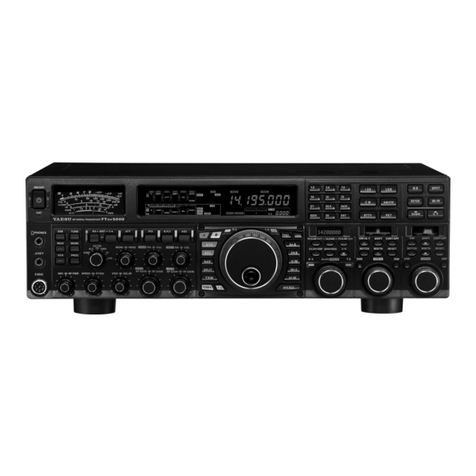
Yaesu
Yaesu FTDX5000 CAT BOOK operating manual

Teledyne Detcon
Teledyne Detcon RXT-320 instruction manual

Trio
Trio TS-530SP instruction manual
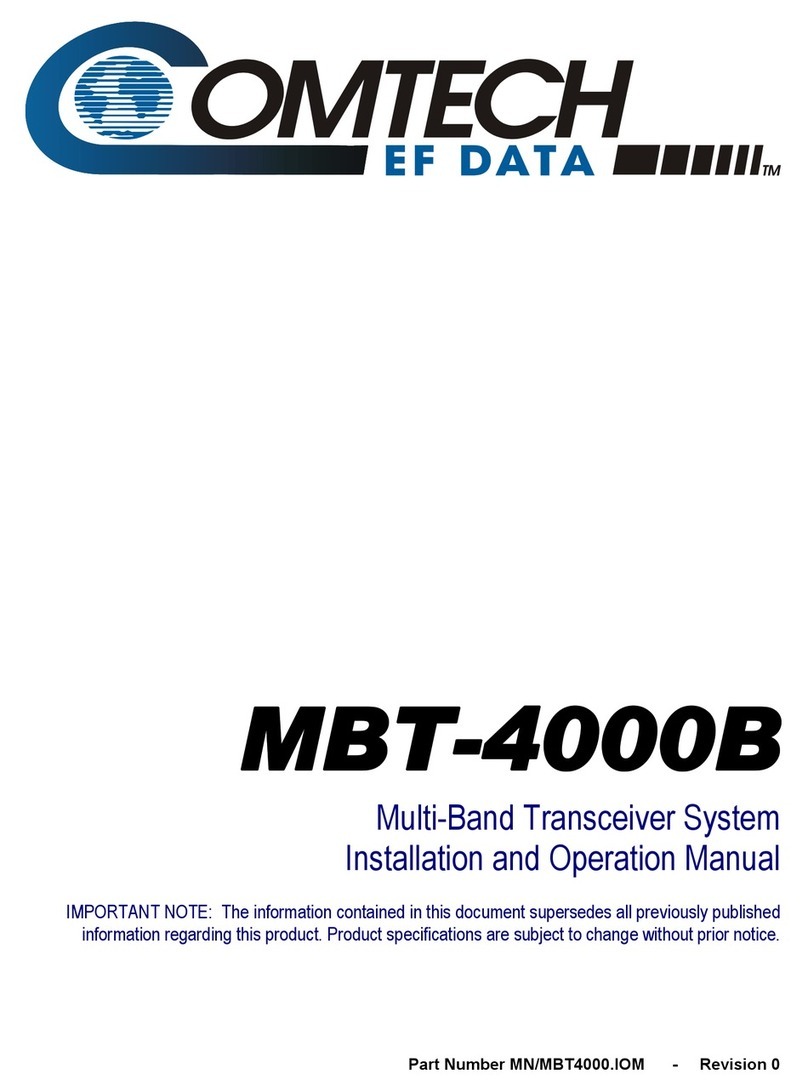
Comtech EF Data
Comtech EF Data MBT-4000B Installation and operation manual
